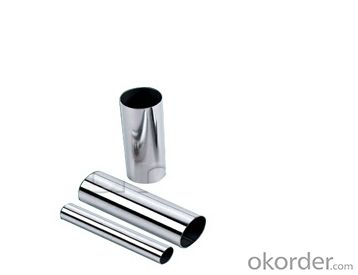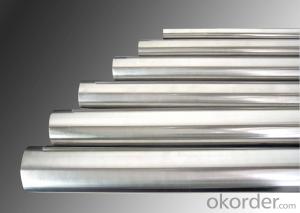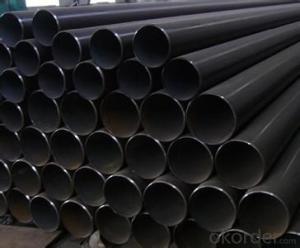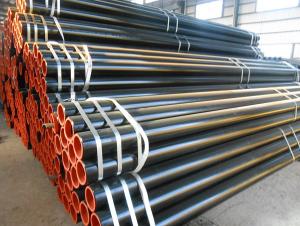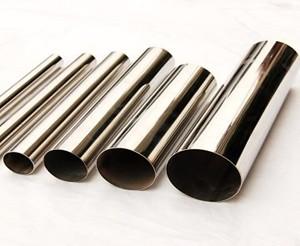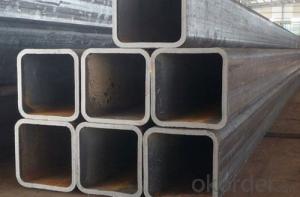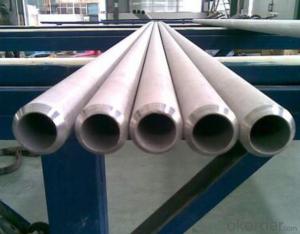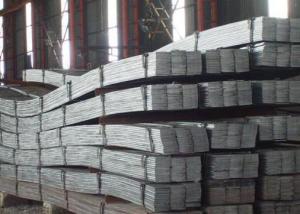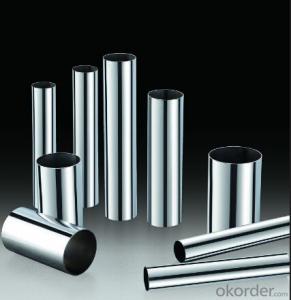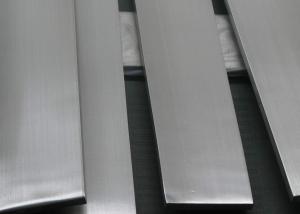Thin Wall Small Diameter Stainless Steel Tubing
- Loading Port:
- China Main Port
- Payment Terms:
- TT or LC
- Min Order Qty:
- -
- Supply Capability:
- -
OKorder Service Pledge
OKorder Financial Service
You Might Also Like
| Specification | |
| Material | 304:0cr18ni9, 0cr17ni8 |
| 201:1cr17mn6ni5n,1cr13mn9ni1n | |
| 316:0cr17Ni12 | |
| or as customer's request | |
| Standard | ASTM A554, Q/GBS1-2005, customers' requests available |
| Size(Round Pipe) | 9.5mm,12.7mm,15.9mm,17mm,18mm,19.1mm,20mm,21mm |
| 22.2mm,23mm,25.4mm,28mm,31.8mm,35mm,38.1mm, | |
| 48mm,50.8mm,60mm,63.5mm,73mm,76.2mm,88.9mm, | |
| 101.6mm,114.3mm,127mm,133mm,159mm,168mm,219mm, | |
| (or customized) | |
| Thickness | 0.24mm-3.0mm |
| Length | 6m or according to customers' request |
| Outer diameter | 6.35mm-219mm |
| Tolerance | Outer diameter:±0.2mm |
| Thickness:±0.05mm | |
| Length:±0.5mm | |
| Process Method | Cold drawn, Annealed with nitrogen protection, Ultrasonic welding, |
| Automatic shape, Polished, Packing. | |
| Ends | In plain end or bevelled ends or as customers' requirements |
| Finishing | A. Sanded |
| B. 400#-600# mirror | |
| C. Hairline brushed | |
| D. TIN titanlum plated | |
| E. HL brushed & mirror(two kinds of finishing for one pipe) | |
| Inner Packing | Plastic bag |
| Outer Packing | Standard gunny packed for each bundle, around 300-500kgs per |
| bundle, or customized according to customers' requests | |
| Application | Heat Interchangers and heaters |
| Decorations, constructions | |
| Oil and chemical industry | |
| Food industry and pharmaceutical industry | |
| Ship-building and automobile manufacturing | |
| Water transportation systems | |
| Performance | Rustless, stainless, good corrosion resistance, anti-wearing, good |
| appearance, excellent mechanical properties | |
| Certification | ISO, SGS,BV. |
| Welding Line Type | ERW(Electrical Resistance Weld) |
| Delivery Detail | 15~25 days, depends on customers' order quantity |
FAQ of Stainless Steel Tubing :
①How is the quality of your products?
Our products are manufactured strictly according to national and internaional standard, and we take a test on every pipe before delivered out. If you want see our quality certifications and all kinds of testing report, please just ask us for it.
Guaranteed: If products’ quality don’t accord to discription as we give or the promise before you place order, we promise 100% refund.
②How about price?
Yes, we are factory and be able to give you lowest price below market one, and we have a policy that “ for saving time and absolutely honest business attitude, we quote as lowest as possible for any customer, and discount can be given according to quantity”,if you like bargain and factory price is not low enough as you think, just don’t waste your time.Please trust the quotation we would give you, it is professional one.
③Why should you chose us?
Chose happens because of quality, then price, We can give you both.Additionally, we can also offer professional products inquiry, products knowledge train(for agents), smooth goods delivery, exellent customer solution proposals.Our service formula: good quality+good price+good service=customer’s trust
SGS test is available, customer inspection before shipping is welcome, third party inspection is no problem.
Any question, pls feel free to contact us !
Stainless Steel Tubing Images
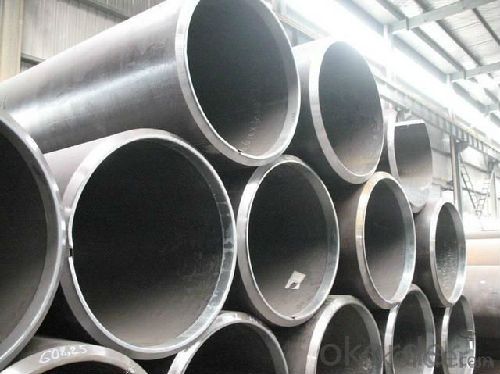
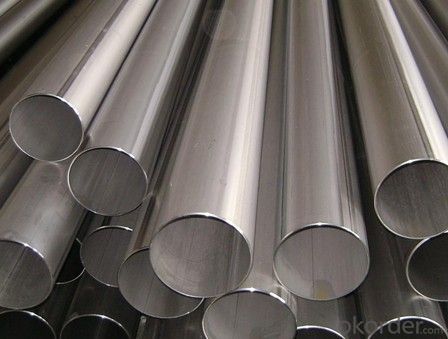
- Q: How do stainless steel pipes compare to titanium pipes?
- Stainless steel pipes and titanium pipes exhibit distinct characteristics, catering to diverse applications based on specific needs. In terms of strength, titanium pipes generally outperform stainless steel pipes. Titanium possesses an impressive strength-to-weight ratio, making it an ideal choice for lightweight yet strong materials. Conversely, stainless steel is renowned for its excellent tensile strength and durability, albeit being relatively heavier than titanium. Regarding corrosion resistance, both stainless steel and titanium pipes demonstrate high resistance to corrosion. Nevertheless, titanium pipes offer superior corrosion resistance, particularly in aggressive environments like seawater or chemical processing applications. Stainless steel pipes also possess good corrosion resistance but might require additional coatings or treatments to enhance their resistance in certain conditions. Temperature resistance is another crucial aspect to consider. Titanium pipes can endure high temperatures without compromising their strength or structural integrity, making them suitable for high-temperature applications in industries such as aerospace or power generation. Stainless steel pipes also exhibit decent heat resistance, but their performance may vary depending on the specific grade of stainless steel and the temperature range involved. Cost is an essential factor as well. Generally, stainless steel pipes are more cost-effective compared to titanium pipes. Titanium, due to its scarcity, intricate fabrication process, and higher production costs, is a pricier material. Hence, if cost is a significant consideration, stainless steel pipes emerge as a more viable option. In conclusion, stainless steel pipes and titanium pipes possess their own merits and aptitude for distinct applications. Titanium pipes excel in terms of strength, corrosion resistance, and heat resistance but come at a higher cost. Stainless steel pipes offer satisfactory strength, corrosion resistance, and cost-effectiveness. Ultimately, the selection between the two relies on the specific requirements, budget, and intended application of the pipes.
- Q: What are the different types of stainless steel pipe tees?
- Different applications and requirements call for various kinds of stainless steel pipe tees. 1. An equal tee is designed with three outlets of the same size, forming a 90-degree angle. It is commonly utilized to branch off or combine flow in a pipeline with equal diameters. 2. A reducing tee, as the name implies, has one outlet smaller than the other two. Its purpose is to connect pipes of different sizes, facilitating a seamless transition in fluid or gas flow. 3. In high-pressure or high-temperature applications, a barred tee provides additional support and reinforcement with a welded bar across the branch opening. This prevents stress concentration and potential failure. 4. For pipeline diversion or angled connections, a lateral tee with one outlet at a 45-degree angle is often employed. 5. A cross tee, featuring four outlets forming a cross-shaped configuration, is used when flow needs to be split or combined in multiple directions, primarily in complex piping systems. 6. Unions and socket weld tees have sockets or unions at the branch connection, allowing for easy disassembly and maintenance. They are commonly used when regular inspection, cleaning, or replacement is required. 7. Threaded tees have threaded branch connections that can be screwed onto the pipe without welding. They are frequently used in low-pressure applications or situations where frequent disassembly is necessary. Each type of stainless steel pipe tee offers specific advantages and is chosen based on the requirements of the particular piping system, including flow rates, pressure, temperature, and compatibility with the transported fluids or gases.
- Q: 304 stainless steel tube with the diameter of 25*2-3 is what mean
- 304 stainless steel tube with the diameter of 25*2-3 said: material for 304 (the equivalent of the American brand, Chinese numbered S30408 stainless steel or 06Cr19Ni10 stainless steel), diameter (OD) for 25mm, for the seamless steel pipe wall thickness of 2 to 3mm.
- Q: How do you measure the thickness of a stainless steel pipe?
- One common method to measure the thickness of a stainless steel pipe is by using a caliper or a micrometer. These tools allow you to accurately measure the outer diameter and inner diameter of the pipe. By subtracting the inner diameter from the outer diameter, you can determine the wall thickness of the pipe.
- Q: How do you prevent galling in stainless steel pipes?
- Stainless steel pipes often encounter a frustrating problem called galling, or cold welding. If not dealt with properly, this issue can cause damage and even failure. Fortunately, there are several steps that can be taken to prevent galling in stainless steel pipes: 1. Lubrication is key. By applying a suitable lubricant to the threaded connections, the risk of galling can be significantly reduced. Lubricants create a barrier between the mating surfaces, minimizing friction and preventing the metal-to-metal contact that leads to galling. It's important to use a lubricant specifically designed for stainless steel to ensure compatibility and effectiveness. 2. Proper pipe installation is crucial. Over-tightening the connections can increase the risk of galling, so it's important to avoid this. Following the torque specifications recommended by the manufacturer and using a calibrated torque wrench can ensure proper installation without putting excessive stress on the threads. 3. Avoiding the use of dissimilar metals in the joint is important when connecting stainless steel pipes. If dissimilar metals come into contact, galvanic corrosion can occur, leading to galling. However, if it's necessary to use dissimilar metals, isolating gaskets or other insulating materials can be employed to prevent direct contact between the metals. 4. Maintaining a smooth surface finish on the threads can help minimize the risk of galling. Rough or damaged threads can create areas of high friction, increasing the likelihood of galling. Thoroughly inspecting and cleaning the threads before installation can help identify any imperfections that need to be addressed. 5. Material selection is crucial in preventing galling. Choosing the right grade of stainless steel is essential. Certain stainless steel alloys, such as 304 and 316, are more resistant to galling due to their higher nickel content. Consulting with a materials expert or referring to industry standards can help determine the most suitable stainless steel grade for a specific application. By implementing these preventive measures, the risk of galling in stainless steel pipes can be significantly reduced, ensuring the longevity and reliability of the piping system.
- Q: What are the limitations of using stainless steel pipes?
- There are several limitations associated with the use of stainless steel pipes. Firstly, stainless steel pipes tend to be more expensive compared to other materials such as PVC or copper. This can make them less feasible for projects with budget constraints. Secondly, stainless steel pipes can be more difficult to install and require specialized tools and equipment. This can increase the overall installation time and cost. Another limitation is that stainless steel pipes are not suitable for transporting certain corrosive chemicals or gases. They may react with certain substances, leading to corrosion and potential damage to the pipes. In such cases, alternative materials like plastic or lined pipes may be more appropriate. Additionally, stainless steel pipes may have limitations in terms of temperature and pressure resistance. While they can handle relatively high temperatures and pressures, extreme conditions may require the use of more robust materials. Furthermore, stainless steel pipes have a lower thermal conductivity compared to other materials, meaning they are not as efficient at transferring heat. This can be a limitation in certain heating or cooling applications where rapid heat transfer is required. Lastly, stainless steel pipes can be prone to expansion and contraction with temperature changes. This may require the use of expansion joints or other measures to accommodate for these movements and prevent potential damage. Overall, while stainless steel pipes offer numerous benefits such as durability and corrosion resistance, their limitations should be carefully considered before selecting them for a particular project.
- Q: Can stainless steel pipes be used for pharmaceutical storage?
- Yes, stainless steel pipes can be used for pharmaceutical storage. Stainless steel is a preferred material in pharmaceutical industry due to its corrosion resistance, hygienic properties, and ease of cleaning. It ensures the integrity and purity of pharmaceutical products, making it suitable for storage and transportation of pharmaceutical materials.
- Q: Can stainless steel pipes be used for dairy processing plants?
- Yes, stainless steel pipes can be used for dairy processing plants. Stainless steel is a popular material choice in the food and beverage industry, including dairy processing plants, due to its excellent corrosion resistance, durability, and hygienic properties. Stainless steel pipes do not react with dairy products and can withstand the harsh cleaning and sanitization processes required in such plants. Additionally, stainless steel pipes have a smooth surface, which minimizes the risk of bacterial growth and allows for easy cleaning and maintenance. Therefore, stainless steel pipes are a suitable and commonly used option in dairy processing plants.
- Q: Can stainless steel pipes be coated with fusion bonded epoxy?
- Yes, stainless steel pipes can be coated with fusion bonded epoxy. This coating provides excellent corrosion resistance and improves the durability of the stainless steel pipes.
- Q: How do you choose the right stainless steel grade for a specific application?
- When choosing the right stainless steel grade for a specific application, several factors need to be considered. These include the desired corrosion resistance, temperature resistance, mechanical properties, and cost-effectiveness required for the application. It is crucial to thoroughly understand the application's environmental conditions, such as exposure to chemicals, moisture, or high temperatures, as this will determine the level of corrosion resistance needed. Additionally, considering the required strength, toughness, and hardness of the stainless steel for the specific application is important. Balancing these factors with the cost-effectiveness of the grade will help in choosing the most suitable stainless steel grade for the application. Consulting with metallurgical experts or referring to industry standards and guidelines can provide further guidance in making an informed decision.
Send your message to us
Thin Wall Small Diameter Stainless Steel Tubing
- Loading Port:
- China Main Port
- Payment Terms:
- TT or LC
- Min Order Qty:
- -
- Supply Capability:
- -
OKorder Service Pledge
OKorder Financial Service
Similar products
Hot products
Hot Searches
Related keywords



